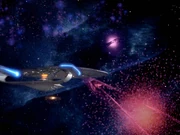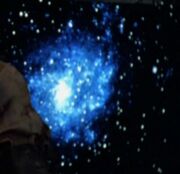
The first Federation-explored region of the Triangulum Galaxy

The Triangulum Galaxy in Voyager's astrometrics
The Triangulum Galaxy (or M-33) was the next closest spiral galaxy to the Milky Way beyond the Andromeda Galaxy.
In 2364, the USS Enterprise-D was hurled 2,700,000 light years, through two galaxies, to the Triangulum Galaxy by the Traveler during warp field tests; after reversing engines, the ship emerged in the vicinity of a giant protostar in the process of formation.
Calculations indicated that a return trip to the Milky Way from Triangulum, using maximum warp speed, would take over three hundred years. A subspace radio message, sent from the Triangulum Galaxy to Starfleet Command, was estimated to have a travel time of fifty-one years set to arrive in the year 2415. (TNG: "Where No One Has Gone Before")
An image of the Triangulum Galaxy, taken from Earth, was on display in astrometrics aboard the USS Voyager in the years 2375 and 2376. (VOY: "Night")
Appendices[]
Appearances[]
Background information[]
According to the Star Trek Encyclopedia (4th ed., vol. 1, p. 291), the Triangulum Galaxy was the "33rd object in Messier's catalog," hence "M-33". In the real world, the Triangulum galaxy is 2,723,000 light years from Earth, and is also known as "NGC 598".
With a return trip time of "over three hundred years" using maximum warp, Federation technology had matched that seen of the Kelvan Empire in the Star Trek: The Original Series episode "By Any Other Name". The Kelvans made a voyage from the Andromeda Galaxy to the Milky Way in three centuries; a feat, remarked at in amazement by James T. Kirk who stated that, in the 23rd century, it would have taken a starship "thousands of years" to travel between galaxies.
